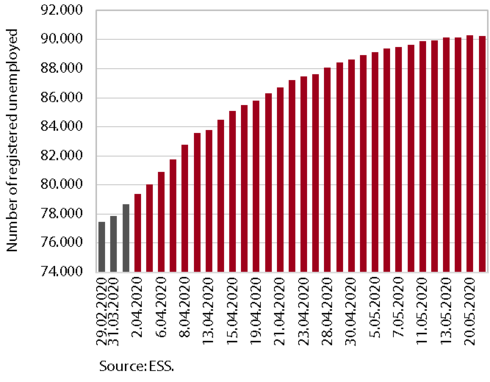Charts of the Week
Current economic trends from 18 to 22 May 2020: labour market, wages, traffic of electronically tolled vehicles, electricity consumption and Slovenian industrial producer prices
After the adoption of measures to contain the COVID-19 epidemic, economic activity started to decline markedly and labour market conditions deteriorated. The average wage in the private sector fell, mainly as a significant portion of workers were posted to temporarily wait for work at home. According to the available indicators, economic activity has started to improve in recent weeks but remains significantly lower than before the outbreak of the epidemic. Electricity consumption by industrial users in April was around one quarter lower than one year earlier, while freight traffic on Slovenian motorways, which has been increasing since mid-April, was around one fifth lower year on year in mid-May. In the second half of April, the deterioration in labour market conditions slowed somewhat, as did the increase in the number of unemployed, which was around one sixth higher in mid-May than before the spread of the epidemic in Slovenia.
Labour market, March – May 2020

The rapid deterioration in labour market conditions has eased somewhat in the last few weeks. After relatively favourable first two months, when employment increased particularly due to the hiring of foreigners, year-on-year growth in employment dropped sharply in March (0.6%; in March 2019, 3.1%). Registered unemployment started to rise after the outbreak of the epidemic in the second half of March. The rapid increase continued in the first half of April. At the end of April, the number of unemployed persons amounted to 88,648, which is 19.9% more than in the same period of last year. On 21 May, it was 90,286 according to EES unofficial daily data, 1.9% higher than at the end of April. The easing of labour market conditions in the last few weeks is attributable to the lifting of containment measures and a resumption of most activities, but also to the adoption of the first legislative package of intervention measures to mitigate the consequences of the epidemic for citizens and the economy.
Wages, March 2020

Year-on-year wage growth dropped sharply in March due to a fall in private sector wages. In the first two months, year-on-year growth in the private sector was still strong (4.7%) due to the increase in the minimum wage and labour shortages in general. With a large part of employed persons posted to temporarily wait for work at home, the average wage was 1.4% lower year on year in March. The decline was particularly pronounced in accommodation and food service activities (18.8%). After moderate growth in the first two months, wage growth in the public sector strengthened slightly in March (3.5%), which was attributable to the agreed promotions at the end of last year, but also to a temporary introduction of additional pay for those with extra workload due to the crisis situation.
Traffic of electronically tolled vehicles on Slovenian motorways, April – May 2020

Freight traffic on Slovenian motorways, which fell markedly after the adoption of measures to contain the spread of the epidemic, has been rising gradually since mid-April. After an almost 40% decline in the first weeks, it was less than one quarter lower year on year in the middle of May. The distance of journeys performed by foreign trucks was still almost a third lower than one year before, while the decline in the distance performed by domestic trucks was significantly smaller. The fall in foreign truck traffic, which was initially much more pronounced than in domestic truck traffic, has decreased under the impact of EU measures for the free flow of goods across borders and due to the easing of measures in some neighbouring countries.
Electricity consumption by consumption group, April 2020

Electricity consumption at the distribution level fell further in April, mostly due to lower industrial consumption. The total electricity consumption by consumers connected to the distribution system was around 15% lower year on year in April. The largest contribution (15 pps) to the decline came from lower industrial consumption (down around 24% year on year), as some production plants and non-essential service activities were shut down due to the epidemic. Negative, albeit far smaller (2 pps), was also the contribution of small business consumption. Household consumption, which was 6.8% higher year on year as, owing to the adopted measures, people mostly stayed at home, made a positive contribution to growth (2 pps). The first preliminary data indicate somewhat smaller year-on-year declines in electricity consumption in the first weeks of May.
Slovenian industrial producer prices, April 2020

Slovenian industrial producer prices were lower year on year in April (by 0.4%). Prices were down particularly on foreign markets, in all industrial groups. Their average year-on-year fall was slightly above 1%. Prices on the domestic market were somewhat higher, mainly on account of higher prices of consumer goods. In recent months, consumption of non-durable goods increased due to the spread of the epidemic, which, according to our estimate, has led to stronger growth in prices of this type of goods (over 3%). Growth in prices of durable consumer goods remains at around 1%. The significantly lower economic activity and the government measure, which reduced electricity prices for households and small business consumers, contributed to a year-on-year price decline in all raw material and energy groups.
